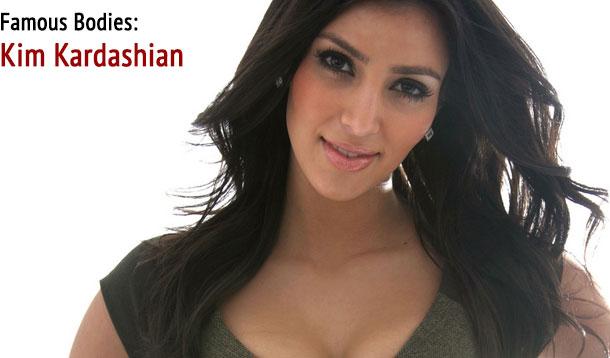
Time for another instalment of our Celebrity Bodies series!
She’s not a mommy yet, but she is the proud owner of some serious child-bearing hips! Kim Kardashian is all over the media and her hourglass figure is usually an object of worship... occasionally, a bad paparazzi shot will try to frame her as “overweight” but in my opinion, there is nothing “over”-anything about her. She is GORGEOUS.
In this time of waif-worship, I like to be optimistic and imagine that a sex-symbol celebrity like Kim Kardashian reminds us of two things:
Women do not have to be stick-thin to be beautiful and sexy.
Women who are not stick-thin are still considered beautiful and sexy, even in our skinny-obsessed culture. So...
There is hope!
Just because she’s got curves doesn’t mean she doesn’t work for that body, though. Here’s how she does it.
FITNESS
I’ll give you a tip. Skechers are not responsible for that ass. Great genes + lots of strength training is the only way to get an ass like Kardashian’s. If you don’t have the genes, you can at least enhance what you’ve got by following a similar training program.
Kardashian works with celebrity trainer Gunnar Peterson, doing strength training three mornings per week, and I have a suspicion there is a LOT of lower body work involved in their routine. Seriously, isn’t her ass insured? Kim’s trainer, Peterson, builds intervals of cardio into her workouts to keep her heart rate high and burn the most fat possible.
Here’s a challenging bodyweight-only routine you can do at home, following the same style of workout that Kim Kardashian does to stay super-fit!
Warm up 5 minutes – run stairs, jog around the block, alternate jumping jacks and jogging on the spot
Perform 1 minute of each of the following exercises, in order, without resting between:
- Bulgarian Split Squat (1 minute per leg)
- Jumping Rope or Jumping Jacks
- Plank
* Repeat for a total of 3 to 5 circuits.
Follow with stretching for all the major muscle groups.
DIET
When your step-dad is an Olympic gold medalist and your mom is FREAKING gorgeous, a burger here and there is probably alright. But there were some slightly less-than-flattering paparazzi pics of Kardashian in 2009 which convinced her to clean up her diet and drop about 15 pounds, she claims.
How?
Honestly, she sold out to Quick Trim and pumped her body full of caffeine pills, laxatives and “detox” beverages in exchange for what we can assume was a hefty paycheque.
But she hasn’t been on Quick Trim all this time, so she’s made some dietary changes to stay at that size 2 (still teeny-tiny by real-world standards, by the way...) since she lost the weight last year. Sensible, lower-carb eating sounds like the system she’s chosen: "I finally said enough with the junk food. These days I prefer salads with grilled chicken or turkey burgers without the bun."
Now she’s “slimming down” for her upcoming wedding... on Quick Trim again.
Hmmm... if it works so well, why should you need to do it again one year later, Kim?
So, let’s take a page from Kim Kardashian on her commitment to strength training and her body confidence, with a big fat NO THANK YOU on the diet supplements. Although her on-again, off-again relationship with Quick Trim makes me wonder just how confident she really is, after all...
What do you think of Kim Kardashian's build and fitness/diet routine? Is she a role model?
"

THE PIKE CRUNCH
Target Body Parts: Hips, Core
Equipment: None
Too challenging? Place hands behind your head instead.
Too easy? Hold a single dumbbell, medicine ball, or heavy object in both hands as you crunch.
And if you're really looking to flatten your midsection for bikini season, check out my top 10 tips for a flat belly.
A little public service message here: There are risks with any kind of exercise. If you are unsure, I always recommend you ask questions first, shoot later. You can shoot me an email at dara[at]fitfamily[dot]ca if you have a question about this or any other exercise.
"

Last week, big strides were made in the WAR ON OBESITY. Does that sound dramatic? I'm trying to sound dramatic here.
The US federal government banished the old "pyramid" food guide in favour of a new plate graphic. "My Plate" simplifies the food groups into a basic pie-diagram that one can literally picture at each meal to be sure portions and food groups are in alignment.
The old food pyramid graphic has been in use in Canada and the US for a couple of decades. It's been edited, streamlined, modified... but there were always some basic issues in my opinion, not the least of which was the overwhelming emphasis on starchy carbohydrates as the "foundation" of a proper eating plan, above even fruits and vegetables. While I don't subscribe to any of the Atkins, Dukan or other carb-phobic diets, I do believe the average person (especially overweight person) consumes way too big a proportion of their calories from starchy carbohydrates.
I eat plenty of yogurt, fruit, vegetables, even occasional potatoes... but I probably eat bread/pasta/rice fewer than 5 times, total, of 21 or more meals per week. I will admit that I don't have that bread lust that my female clients, friend and relatives complain of. But I can go crazy over a baguette with butter, just like the average gal... I just don't bring it into the house.
The new My Plate emphasizes vegetables and to a lesser degree, fruits. Produce should make up half of your plate at each meal... in other words, in case you're missing the big picture:
Vegetables & fruits should make up half of your diet. Grains? About a quarter only.
Another issue I have with the old food pyramid is the generalization of all "fats" into that scary "treat" area at the top of the pyramid. There are plenty of healthy fats that should make up a proportion of approximately 15-25% of one's diet, depending on body type, goals and training regime. Under no circumstances should healthy, necessary fats like a handful of olives or some sliced avocado on a salad be categorized together with chocolate bars and cupcakes. Those are two totally different animals.
The new My Plate contains no fat at all. No fat? Perhaps the assumption is that some of those vegetables, proteins and starches have been cooked in a bit of oil or might be drizzled with a bit of oil. Not to include fats in the graphic is pretty large oversight, in my opinion. I regularly consume fish, nuts and seeds, avocado (with a spoon, right out of the peel... yum!), full-fat yogurt and some other dairy, olive oil, grapeseed oil and even canola oil. Plus, I like to have a good pizza or some other fun times about once per week. Fat is fantastic on the tongue, crucial to the functioning of your central nervous system and the absorption of vitamins, and carries fantastic anti-inflammatory properties if you're selecting an omega-3 source such as olives, walnuts, avocados, coconut, etc. Fat also helps fill you up and decreases the need for sugar and salt to improve a food's flavour.
There is some controversy about the inclusion of dairy. Lactose intolerance seems to be on the rise, and more people are choosing soy, almond, coconut and rice milk alternatives instead of relying on cow's milk, for ethical and environmental reasons. In my house, we drink milk. I enjoy alternatives but my family doesn't, so I buy good old fashioned 2% Canadian cow's milk. Whether you support the modern dairy industry or not, I think the inclusion of dairy is still relevant. Public health campaigns like My Plate are often targeted with parents in mind, since they control the health of the future generations, to a large extent. Children need milk. Especially young children. I believe that's true. And unless we're going to go back to breastfeeding for the first 5-6 years of life, they're going to need to get that milk from somewhere. So choose your "dairy": almond, rice, goat, soy, coconut or cow (or human?...), and include it in your family's daily diet to ensure adequate protein, calcium, vitamin and mineral consumption.
Overall, I think My Plate is a great step in the right direction. I'll be watching for some similar changes to the Canada Food Guide. In the meantime, I'll keep feeding my family and myself in a manner that does happen to roughly correspond to the My Plate graphic, although perhaps with slightly less emphasis on grains for Sweaty Hubby and myself, who are no longer growing (at least not in an upward manner...).
What do you think of My Plate? How do you balance macronutrients (protein, fat, carbohydrate) in your daily diet and your family's diet?